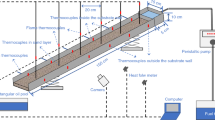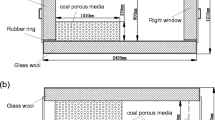Abstract
The occurrence of a liquid fuel burning on carpet has been involved in many incendiary and accidental fires. While the research on a liquid fuel fire on carpet is still limited, much work on porous media has been performed using sand or glass beads soaked with liquid fuel. In this study, a heat and mass transfer theory was first developed to analyze the burning process of liquid on carpet, and then several small-scale tests were performed to validate the theory. This analysis is valid for pool fires intermediate in size (5–20 cm. in diameter). The experimental apparatus consisted of a circular pan (105 mm) and a load cell. Varying amounts of fuels (heptane, kerosene and methanol) were spilled onto the carpet, which was allowed to burn in a quiescent environment. It was found that due to the different controlling mechanisms, the liquid burning rate could be less or more than that of a similarly spilled free-burning pool fire. For the worst-case scenario in fires, the maximum enhancement of the burning rate due to the porous media is predictable through the physical properties of the fuel. This analysis is valid for both combustion and evaporation. Several similar results in the scientific literature are analyzed to further describe the trend. This work explains the role of carpet in liquid pool fires and also helps to explain special risks related to the presence of carpet involved in arsons and will be useful in reconstruction of the early development of an incendiary or accidental fire.
Similar content being viewed by others
References
I.A. Benjamin and S. Davis, “Flammability Testing for Carpet,” Fire Technology, vol. 15, no. 3, 1979, pp. 189–194.
R. Roby and D.J. Carpenter, “The Role of Carpet in Determining Origin and Cause of a Compartment Fire,” Fire and Arson Investigator, October 1999.
P. Joulain, “The Behavior of Pool Fires: State of the Art and New Insights,” 27th Symposium on Combustion, 1998, pp. 2691-2706.
V.L. Blinov and G.H. Khudiakov, “Certain Laws Governing Diffusive Burning of Liquids,” Accademmiia Nauk, SSSR Doklady, vol. 113, 1957, pp. 1094–1098.
M. Hottel, “Certain Laws Governing Diffusive Burning of Liquids,” Fire Research Abstracts and Reviews, vol. 2, 1958, pp. 41–44.
D.B. Spalding, “The Combustion of Liquid Fuels,” 4th Symposium on Combustion, 1953, pp. 847-864.
D.S. Burgess, A. Strasser, and J. Grumer, “Diffusive Burning of Liquid Fuels in Open Trays,” Fire Research Abstracts and Reviews, vol. 3, 1961, pp. 177–192.
K. Akita, “Some Problems of Flame Spread Along a Liquid Surface,” 14th Symposium on Combustion, 1973, pp. 1075-1082.
M. Klassen, J.P. Gore, and Y.R. Sivathanu, “Radiative Heat Feedback in a Toluene Pool Fire,” 24th Symposium on Combustion, 1992, pp. 1713-1719.
A. Hamins, J.C. Yang, and T. Kashiwagi, “A Global Model for Predicting the Burning Rates of Liquid Pool Fires,” NISTIR6381, 1999.
H. Hayasaka, “Unsteady Burning Rates of Small Pool Fires,” 5th Symposium on Fire Safety Science, 1997.
H. Ishida, “Flame Spread over Fuel-soaked Ground,” Fire Safety Journal, vol. 10, 1986, pp. 163–171.
K. Takeno and T. Hirano, “Flame Spread over Porous Solids Soaked with a Combustible Liquid,” 21st Symposium on Combustion, 1986, pp. 75-81.
T. Takeuchi, T. Tsuruda, S. Ishizuka, and T. Hirano, “Burning Characteristics of a Combustible Liquid Soaked in Porous Beds,” 3rd Symposium on Fire Safety Science, Edinburgh, Scotland, July 1991.
T. Suzuki and T. Hirano, “Effects of Gasification Properties of a Combustible on Flame Spread over its Surface,” 3rd Symposium on Fire Safety Science, Edinburgh, Scotland, July 1991.
P.L. Blackshear Jr. and M.A. Kanury, “Heat and Mass Transfer to, from and Within Cellulosic Solids Burning in Air,” 10th Symposium on Combustion, 1965, p. 811.
Y.X. Tao and M. Kaviany, “Burning Rate of Liquid Supplied Through a Wick,” Combustion and Flame, vol. 86, 1991, pp. 47–61.
B.T. Wentworth and J.L. Torero, “The Effect of External Radiation and a Porous Media on Ignition and MassTransfer of a Liquid Fuel,” in Proceedings of NHTC'01, June 10-12, Anaheim, California, 2001.
J.D. DeHaan, “The Reconstruction of Fires Involving Highly Flammable Hydrocarbon Liquids,” PhD Thesis, University of Strathclyde, Glasgow, 1995
NIST website for material properties, http://webbook.nist.gov/chemistry/.
A. Putorti, J.A. McElroy, and D. Madrzykowski, “Flammable and Combustible Liquid Spill/Burn Patterns,” NIJ Report 604-00, 2000.
SFPE Handbook of Fire Protection Engineering, 2nd ed., 1995.
V. Babrauskas, W.H. Twilley, and W.J. Parker, “Effects of Specimen Edge Conditions on Heat Release Rate,” Fire and Materials, vol. 17, no. 2, 1993, pp. 51–63.
P.G. Seeger, “On the Combustion and Heat Transfer in Fires of Liquid Fuels in Tanks,” Heat Tranfer in Fires, P.L. Blackshear, ed., 1974.
Author information
Authors and Affiliations
Rights and permissions
About this article
Cite this article
Ma, T., Olenick, S.M., Klassen, M.S. et al. Burning Rate of Liquid Fuel on Carpet (Porous Media). Fire Technology 40, 227–246 (2004). https://doi.org/10.1023/B:FIRE.0000026878.29456.3c
Issue Date:
DOI: https://doi.org/10.1023/B:FIRE.0000026878.29456.3c




